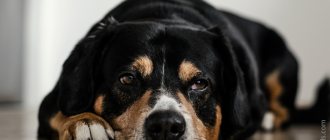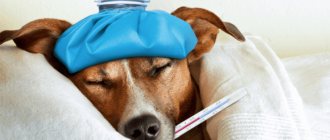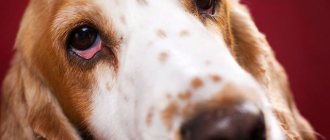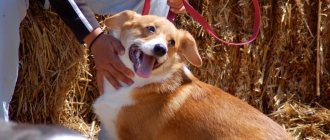Severe tearfulness in a dog is mainly a protective reaction of the body aimed at removing foreign external objects, as well as pathogenic microorganisms, from the eye.
Discharge, especially purulent discharge from the eyes, signals the owner about a disease of the eye or other internal organs, as well as the presence of an infectious disease, which, if timely treatment measures are not taken, can lead to blindness.
When is discharge from the eyes normal, and when is it pathological?
For some breeds of dogs that have sagging cheeks, flat faces, and protruding eyes, this is normal. These breeds include Yorkshire terriers, Shih Tzu, toy terrier, boxer, collie, Pekingese. Tear marks are especially noticeable in dogs with light fur.
Structure of the lacrimal apparatus
Lacrimation is a natural reaction of the body to severe irritation of the mucous membrane of the sclera or conjunctiva.
When epiphora develops, it cannot be considered as an independent pathology, since it is only a sign that sometimes indicates more dangerous diseases.
The lacrimal apparatus consists of lacrimal glands and lacrimal ducts. The gland secretes a clear, slightly alkaline mixture that flows into the eyes; its components are water, protein, salts and lysozyme, which has an antibacterial effect. It is important to mention Harder's lacrimal gland. Despite its name, it does not form tears, but an oily mixture.
The lacrimal ducts have lacrimal puncta, which are located closer to the eyeball and are immersed in the lacrimal lake. Next come the channels (lower and upper), it is turned towards the nose. The canals run separately and pass into the apical lobe of the lacrimal sac. Along the path of the tear ducts there are a number of valves that block the movement of tears in the opposite direction, which is why the liquid moves only from the eyes to the nose and into the mouth.
Tears from the glands go under the conjunctiva, and then, under their own weight and due to the blinking of the eyelids, they flow into the tear pool. Here the fluid is absorbed by the lacrimal puncta, then it flows through the lacrimal canaliculi and penetrates into the lacrimal sac, and from it into the nose and mouth.
When is increased tear production normal in dogs?
To begin with, let's agree that if a dog has tears flowing from his eyes in moderate quantities, for example, when yawning, after sleep, or being in the cold or in the wind, then there is nothing to worry about. In addition, the eyes almost always water in brachycephalic dogs (pugs, boxers, etc.) and often in dogs with an abundance of folds on the muzzle (Neapolitan mastiffs, sharpeis, etc.), as well as in animals with long hair falling into the eyes ( poodles, shih tzus, lewchens, etc.). But the constant release of watery, and even more so purulent or bloody exudate should alert you, because these are clear signs of some kind of disease.
Causes of pathology
The causes of epiphora are varied. All diseases should be differentiated into 2 categories:
- Blocking the mechanism of tears flowing out.
- Excessive tear production.
When tear drainage is blocked, the following diseases are most often recorded:
- Atresia of lacrimal openings. This is a genetic abnormality and is found in few breeds.
- Narrowing of the lacrimal openings or canaliculi.
- Inversion or inversion of the lower eyelid, which creates an anatomical discrepancy between the points and the lake.
- Foreign body in the lacrimal system.
- Dacryocystitis.
- An allergy or inflammation of an infectious nature leads to severe swelling in the nasal sinuses, which leads to mechanical compression of the nasolacrimal duct.
- A mucus plug in the lacrimal drainage system.
- Swelling or inflammation near the lacrimal drainage system.
Epiphora is also accompanied by increased tear production:
- Trichiasis. A genetic abnormality that results in two rows of eyelashes on the eyelids and as a result the eye is often irritated by the eyelashes.
- Blepharitis.
- Inflammation of the conjunctiva.
- Keratitis.
- Uveitis.
- Mechanical injury to the cornea.
- Foreign inclusions under the conjunctiva or on the third eyelid.
- The effect of allergens and irritants (dust, pollen, smoke).
- Glaucoma.
- Iridocyclitis.
- Tumor of the eyelids.
- Excessively strong secretion of the lacrimal glands (an extremely rare anomaly).
Sometimes epiphora is caused by the personal anatomical features of certain breeds. It is often recorded in long-haired cats. Persian and Himalayan breeds are predisposed to epiphora.
Other whitening cosmetics
whitening gel (USA) provides safe and effective removal of stains from urine, tears, saliva, food, and also strengthens hair. The transparent gel is applied to dry fur with a brush or hands. It is removed after some time or remains on the coat for 2-3 days. Fresh stains are removed without a trace after 1-2 applications of the gel. Old stains require more time to remove - use the gel daily for 7-10 days. The cost of the gel is about 1300 rubles.
Whitening spray conditioner Ring5 Whitener Cleaner (USA) enhances whiteness (optical illusion), preserves the natural silky texture of the hair and adds volume. The cosmetic mask masks the yellowish tint and removes dust.
Conditioner Anti-Yellowing eliminates yellowness, restores and strengthens hair. Does not cause irritation and does not cause dryness. The conditioner is applied after washing the coat with shampoo (Iv San Bernard Cristal Clean Shampoo Anti-Yellowing whitening shampoo is available on sale) for a few minutes, then rinsed off with water. The cost of an air conditioner is approximately 1200 rubles.
In cases where the coat is lightly colored, a whitening effect can be achieved by using gentle cosmetics that contain natural moisturizers of natural origin (hyaluronic acid, chitosan), coconut oil, and vitamins.
Symptoms of pathology
You can recognize epiphora by several signs :
- The hair near the inner corner of the eye is always damp, often turning brown, this is due to tear pigment.
- A common manifestation of epiphora is brown tear tracks in the corners of the eyes.
- Over a long period of time, skin inflammation develops in the area of the inner corner.
- Often there is itching in the area of the eye socket, scratching on the face, and a concentration of dried brownish exudate in the inner corner of the eye.
Corneal ulcers
These can be superficial or deep ulcers, which can be painful. They can be caused by injury to the cornea, illness, lack of tears, a foreign object in the eye, and other injuries.
Corneal ulcers cause red and watery eyes, light sensitivity, squinting, paw rubbing, a film on the eye, and discharge.
Treatment may require surgery, antibiotics, or anti-inflammatory drugs. Seek medical attention for your pet immediately.
Diagnostics
Lacrimation must be differentiated from tears or purulent exudate.
A study is being conducted with a silver-based drug. If everything is in order, then it appears in the nostrils 10 seconds after entering the eyes. This experiment will provide information about the location of the blockage. In this case, the drug is instilled into the upper lacrimal punctum. When the substance does not come out of the lower one, a blockage of the upper or lower tubule, a blockage in the sac, should be diagnosed, sometimes this is due to the anatomical absence of the lacrimal punctum.
If there is an anomaly in the structure of the nose or its sinuses, a rhinoscopy is performed with a biopsy of all strange parts; the exudate can be collected for microbial analysis. If the exudate is pus, then a microbial analysis must be done before prescribing therapy.
An x-ray will provide some information. In particular, damage to the bones of the nose, sinuses, and upper jaw can be established.
What to do if your dog's eyes are running
So, for no apparent reason at first glance, the dog’s eyes began to become very watery and itchy. What should the owner do in such a situation? Of course, the best decision is to show your pet to a veterinarian (ideally a veterinary ophthalmologist) as soon as possible. However, you can start providing first aid yourself:
- First, the sterile bandage is cut into small strips; they will be needed to clean the eyes. It is better not to use cotton wool, as it can easily get into the animal’s already inflamed eye;
- Then you need to brew an anti-inflammatory decoction of herbs (chamomile, St. John's wort). The broth must be filtered and cooled. You can treat your pet’s eyes with a special hygienic composition (“Api-San Rosinka”, “Veda Green Tea” or “Veda Calendula”, etc.), as well as with regular strained tea leaves. With a bandage soaked in an antiseptic, carefully wipe both eyes (even if only one is leaking). It is important to note that individual pieces of bandage are taken for the right and left eyes. A similar procedure is performed at least 3-5 times a day or more often if necessary;
- You can relieve inflammation and increased tearing with the help of veterinary eye drops (Tsiprovet, IRIS, Dekta-2). Use such products up to 3-4 times a day for 5 days. It is important that before instillation the eyes are cleared of discharge or dried crusts;
- If veterinary medications for the eyes are not available, you can use the usual "Levomycetin". Such drops are instilled 4-6 times a day;
- Tetracycline ointment is good at calming inflammation and stopping the secretion of tears or pus. It is placed behind the lower eyelid of the eye, then the eyelid is closed and gently massaged to distribute the product. Use this drug 3-5 times a day for at least 3 days;
- If there is any small foreign body in the dog's eye (for example, lint), it will require rinsing with clean, lukewarm boiled or still bottled water or chamomile decoction (not hot and strained). For such purposes, it is best to arm yourself with a clean bowl (it will contain water or broth) and a large number of pieces of bandage. Each time, the bandage is generously moistened with liquid, and then the closed eye is carefully wiped from the outer corner to the inner (so that the foreign object moves to the third eyelid and can be removed).
Perhaps all of the measures listed are all that can be done at home. If after several days of treatment the condition of the dog’s eyes does not improve, pus or bloody discharge constantly flows, the animal suffers from unbearable itching and pain, it is worth visiting the veterinary clinic. Unfortunately, a dog’s eyes often run for very serious reasons, when only surgical intervention and the use of serious veterinary medications can help, as, for example, happens with entropion or keratitis.
Treatment
The goal of epiphora therapy is to eliminate the cause of excessive tear flow:
- For conjunctivitis, keratitis or uveitis, the leading role is taken by taking anti-inflammatory drugs.
- If foreign bodies are detected, an operation is performed to remove them.
- Unnecessarily, one should not resort to the use of local glucocorticoids, as they have a destructive effect on the cornea, conjunctiva and other tissues of the visual system.
- For trichiosis and other anomalies, cryosurgery and electrolysis are used.
- In case of atresia of the lacrimal punctum, it is created surgically. A similar operation is performed for cicatricial fusion of the lacrimal opening as a result of severe conjunctivitis.
- If the nasolacrimal duct is narrowed or blocked, dacryocystorhinostomy is performed in various modifications (using external or internal access).
- For inflammation, antibiotic treatment is used locally until microbial data are obtained.
- Therapy of dacryocystitis requires information from microbial research. The treatment is long-term, taking about 3 weeks (and another week after symptoms disappear). The lack of results after a week of therapy suggests a foreign object or a source of long-term infection. For chronic dacryocystitis, catheterization of the nasolacrimal duct is performed.
After eliminating the main cause of lacrimation, epiphora usually goes away, but in some cases it recurs.
Conjunctivitis
Mucus, yellow-green pus, or watery discharge may be signs of conjunctivitis, an inflammation of the lining of your dog's eye. There is a wide range of causes for conjunctivitis, from allergies, injuries, birth defects and tear duct problems to foreign bodies, dry eyes, plague or even tumors.
Other signs of conjunctivitis include very red eyes, inflammation, excessive blinking, squinting, crusty eyes, scratching with paws, or closing of the eyelids.
To treat conjunctivitis, it is important to know what causes it.
Depending on the cause, treatment may include: removing the irritant and soothing the area with pain medication; antibiotics and saline solutions to fight infection; surgery to treat duct disease or birth defects; antihistamines for allergies; or other medications.
Diseases accompanied by tearing
There are a large number of ailments that cause lacrimation. Before starting treatment, it is recommended to understand what caused this pathology. The production of tears is caused not only by the disease, but also by the characteristics of a particular breed.
Conjunctivitis
Inflammation of the conjunctiva occurs for a number of reasons. If treatment is not started immediately, serious consequences cannot be avoided. Some of the characteristic symptoms are the flow of tears, which after a certain period of time turns into mucus, the dog does not tolerate bright lighting, and squinting is observed. Treatment directly depends on the form of the disease and can only be determined by a veterinarian. Usually the doctor prescribes zinc sulfate or silver nitrate in the form of drops.
Advice! Consult a doctor immediately, the disease is accompanied by injuries, and sometimes stitches are required.
Blepharitis inflammation of the eyelids
This type of disease appears due to herbs, systemic pathologies of the pet’s body, allergies, and demodicosis. A sign of blepharitis is visible redness of the conjunctiva. However, there are also other symptoms - swelling, active loss of hair and eyelashes, itching in the eye area, and the appearance of scales.
Keratoconjunctivitis
Keratoconjunctivitis is a pathology that occurs during a deficiency in the synthesis of tear fluid. In some breeds of animals, this type of disease is inherited from their producers. Characteristic signs of the disease are discharge in the form of pus, the appearance of edema, constant blinking, dryness, and hyperemia.
Eversion of the eyelids
When the eyelids are everted, the lacrimal punctum is located above the lacrimal lake, tears begin to overflow and therefore lacrimation is observed. As a result, the skin under the eyes is constantly moist, which causes the appearance of eczema. To eliminate the problem, complex therapy and surgical intervention are required.
Inversion of the eyelids is also observed - the free edge of the eyelid is completely or partially turned inward. Then increased lacrimation occurs, because eyelashes and hairs from the skin come into contact with the cornea, causing irritation and unpleasant consequences. Immediate intervention is done.
Attention! If a dog begins to squint constantly, this is a spasm of the eyelids.
Glaucoma
Glaucoma is another type of pathology. The disease manifests itself as redness of the pupils and high internal pressure. The appearance of tear discharge occurs, but in small quantities. If timely help and treatment are not provided, the dog loses its vision. With glaucoma, the dog begins to be afraid of bright lighting, lethargy appears, appetite completely or partially disappears, and the eyeballs increase in size.
Injury
Dogs, and this is the case with curious breeds, suffer eye injuries partly due to their excessive interest. During injury, inflammation begins to actively develop. The severity of the disease directly depends on how quickly first aid is provided and treatment is prescribed.
Allergy
The most common occurrence is an allergic reaction in pets. This is caused by dust or dirt, detergents or cleaning products, pollen from plants, and medications getting into the eyes. In addition, allergies appear from new food that the owner has introduced into the diet. Symptoms include coughing, sneezing, and redness.











